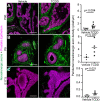A mechanism linking perinatal 2,3,7,8 tetrachlorodibenzo-p-dioxin exposure to lower urinary tract dysfunction in adulthood
- PMID: 34318329
- PMCID: PMC8326766
- DOI: 10.1242/dmm.049068
A mechanism linking perinatal 2,3,7,8 tetrachlorodibenzo-p-dioxin exposure to lower urinary tract dysfunction in adulthood
Abstract
Benign prostatic hyperplasia/lower urinary tract dysfunction (LUTD) affects nearly all men. Symptoms typically present in the fifth or sixth decade and progressively worsen over the remainder of life. Here, we identify a surprising origin of this disease that traces back to the intrauterine environment of the developing male, challenging paradigms about when this disease process begins. We delivered a single dose of a widespread environmental contaminant present in the serum of most Americans [2,3,7,8 tetrachlorodibenzo-p-dioxin (TCDD), 1 µg/kg], and representative of a broader class of environmental contaminants, to pregnant mice and observed an increase in the abundance of a neurotrophic factor, artemin, in the developing mouse prostate. Artemin is required for noradrenergic axon recruitment across multiple tissues, and TCDD rapidly increases prostatic noradrenergic axon density in the male fetus. The hyperinnervation persists into adulthood, when it is coupled to autonomic hyperactivity of prostatic smooth muscle and abnormal urinary function, including increased urinary frequency. We offer new evidence that prostate neuroanatomical development is malleable and that intrauterine chemical exposures can permanently reprogram prostate neuromuscular function to cause male LUTD in adulthood.
Keywords: Artemin; Dioxin; Lower urinary tract dysfunction; Noradrenergic; Prostate; Smooth muscle.
© 2021. Published by The Company of Biologists Ltd.
Conflict of interest statement
Competing interests The authors declare no competing or financial interests.
Figures





References
-
- Abler, L. L., Mehta, V., Keil, K. P., Joshi, P. S., Flucus, C.-L., Hardin, H. A., Schmitz, C. T. and Vezina, C. M. (2011). A high throughput in situ hybridization method to characterize mRNA expression patterns in the fetal mouse lower urogenital tract. J. Vis. Exp. 54, 2912. 10.3791/2912 - DOI - PMC - PubMed
-
- Arima, A., Kato, H., Ise, R., Ooshima, Y., Inoue, A., Muneoka, A., Kamimura, S., Fukusato, T., Kubota, S. and Sumida, H. (2010). In utero and lactational exposure to 2,3,7,8-tetrachlorodibenzo-p-dioxin (TCDD) induces disruption of glands of the prostate and fibrosis in rhesus monkeys. Reprod. Toxicol. 29, 317-322. 10.1016/j.reprotox.2009.12.007 - DOI - PubMed
-
- Baloh, R. H., Tansey, M. G., Lampe, P. A., Fahrner, T. J., Enomoto, H., Simburger, K. S., Leitner, M. L., Araki, T., Johnson, E. M. and Milbrandt, J. (1998). Artemin, a novel member of the GDNF ligand family, supports peripheral and central neurons and signals through the GFRalpha3-RET receptor complex. Neuron 21, 1291-1302. 10.1016/S0896-6273(00)80649-2 - DOI - PubMed
Publication types
MeSH terms
Substances
Grants and funding
LinkOut - more resources
Full Text Sources
Molecular Biology Databases

